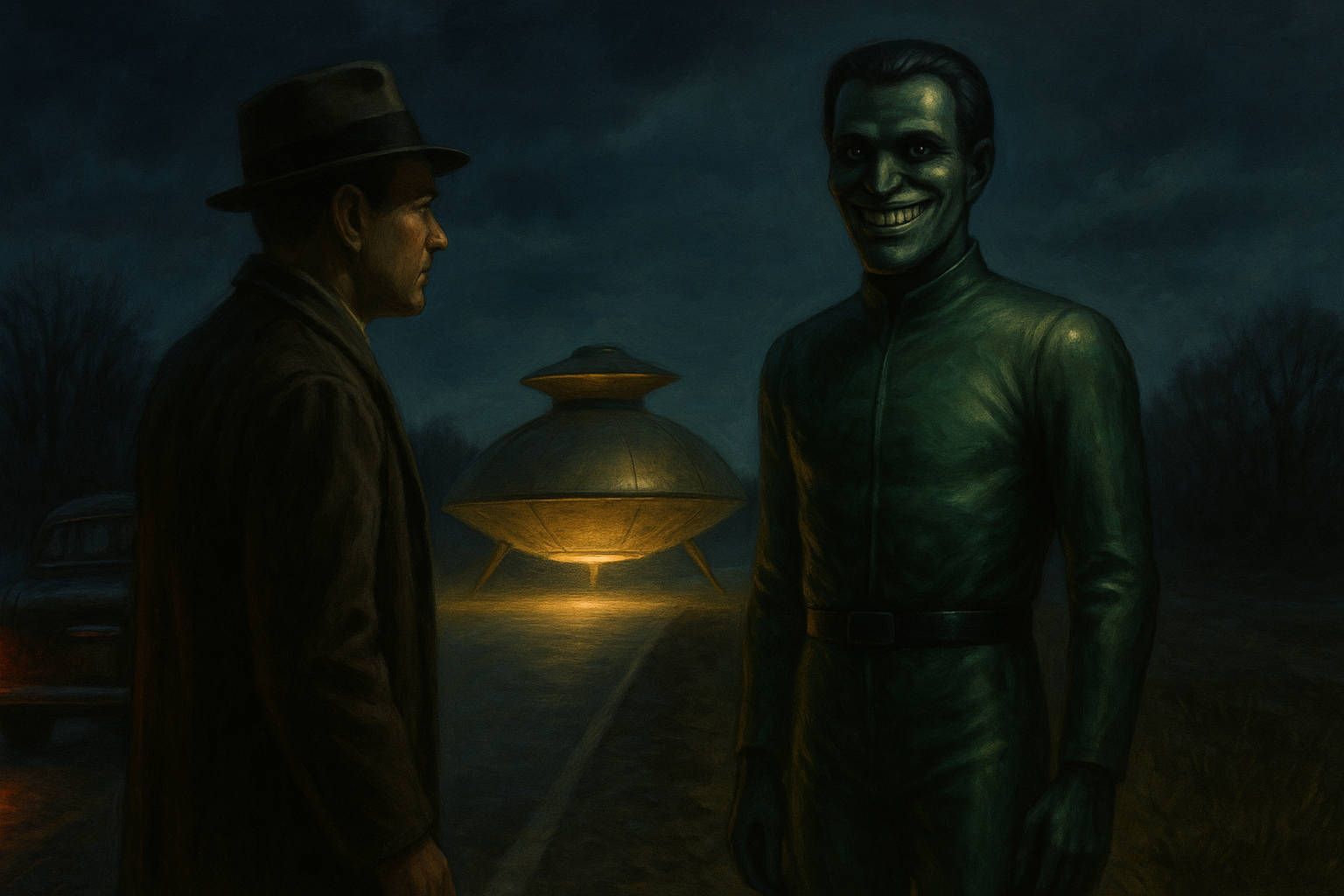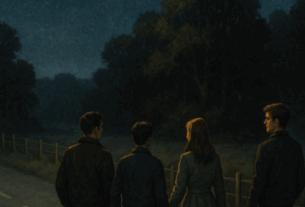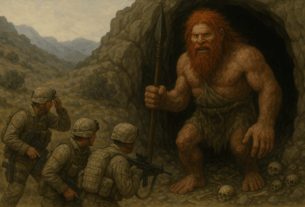Indrid Cold, often referred to as the Smiling Man or the Grinning Man, is a legendary humanoid figure entrenched in 20th-century folklore, particularly associated with UFO encounters and cryptid sightings. The character first emerged in a widely publicized incident on November 2, 1966, when Woodrow Derenberger, a sewing machine salesman from Parkersburg, West Virginia, claimed to have encountered a being who identified himself as Indrid Cold. Driving home on Interstate 77 around 7:30 p.m., Derenberger said a strange vehicle—described as resembling an old kerosene lamp globe with a flat bottom and domed top—landed in front of his truck, blocking the road. A tall, human-like figure emerged, dressed in a reflective green suit with a black belt, sporting a dark complexion, small beady eyes, and a wide, uncanny smile. Cold communicated telepathically, assuring Derenberger he meant no harm and came from a less powerful country, promising to return for further contact before departing in his craft.
Derenberger’s story exploded in the media after he held a press conference the next day, November 3, 1966. WTAP-TV aired a 30-minute interview, sparking a frenzy of local coverage that lasted three weeks. Others came forward with similar claims: some saw a man matching Cold’s description trying to flag them down, while others reported lights and “fluttering vehicles” on the same road. Derenberger later claimed Cold visited him frequently, often arriving by car for friendly chats, and even took him to Cold’s home planet, Lanulos, in the Genemedes galaxy—a planet supposedly populated by beings like Demo Hassan and Karl Ardo. These accounts were detailed in Derenberger’s 1971 book Visitors from Lanulos, but they came at a steep personal cost. He faced ridicule, harassment, and mental health struggles, including depression and headaches, losing his job, friends, and marriage before moving away, only to return to Mineral Wells before his death in 1990 at age 74.
Indrid Cold’s legend grew through the work of paranormal investigator John Keel, who popularized the entity in his 1970 book Strange Creatures from Time and Space and 1975’s The Mothman Prophecies. Keel linked Cold to the Mothman sightings in Point Pleasant, West Virginia, which began November 15, 1966, just 13 days after Derenberger’s encounter. Keel described other sightings, including one on October 11, 1966, in Elizabeth, New Jersey, where two boys, Martin “Mouse” Munov and James “Jimmy” Yanchitis, saw a tall, bald man in a reflective green suit with a huge grin standing behind a fence, staring at them before chasing them. Keel suggested Cold might be an ultraterrestrial or cryptid, possibly tied to the Men in Black, a theory fueled by Cold’s appearance in a blue suit in later accounts and his lack of facial features like ears or a nose in some descriptions.
The Smiling Man trope evolved over time. While Derenberger portrayed Cold as a benign “Space Brother” offering healing medicine, later depictions cast him as a sinister figure. The Lilly family in Point Pleasant reported poltergeist activity around the same time, with daughter Linda waking to see a grinning man over her bed, who vanished when she screamed. Keel himself claimed to receive phone calls from Cold, including a warning to flee before the 1967 Silver Bridge collapse, which killed 46 people—an event often associated with Mothman lore. By the 21st century, Cold became a horror trope, appearing in the 2002 film The Mothman Prophecies as a mysterious caller and in a 2016 episode of Scary Endings, where his grin and erratic behavior, like dancing and sky-gazing, took on a menacing tone.
Skeptics challenge Cold’s existence. Brian Dunning of Skeptoid Magazine argues Derenberger’s story brought him no gain, only personal ruin, suggesting he may have become delusional, as Keel noted Derenberger was “hiding behind drawn curtains” a year later, overwhelmed by believers and skeptics alike. John C. Sherwood’s 2002 Skeptical Inquirer article revealed discrepancies in Keel’s accounts, accusing him of blurring fact and fiction, possibly influenced by UFO author Gray Barker, who may have prank-called Keel as Cold. The lack of physical evidence—no photos, no craft, no Lanulos artifacts—further undermines the story. Some speculate Cold could be a misidentified human, a psychological projection, or a cultural artifact of 1960s UFO hysteria, amplified by rural isolation and Cold War fears.
Indrid Cold’s legacy endures in pop culture and folklore. The Mothman connection, reinforced by the 2002 film where Cold’s voice is implied to be non-human, keeps him tied to Point Pleasant’s cryptid history. On X in 2025, users still debate his origins, with some linking him to Valiant Thor, a supposed alien who influenced contactees in the 1950s. Whether an alien, a cryptid, or a myth, Indrid Cold remains a haunting symbol of the unknown, his eerie grin a reminder of the thin line between reality and imagination in UFO lore.


